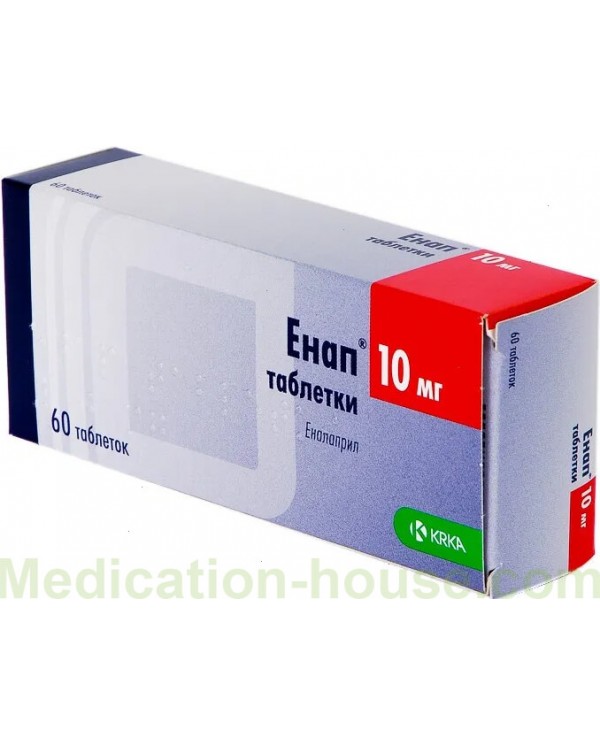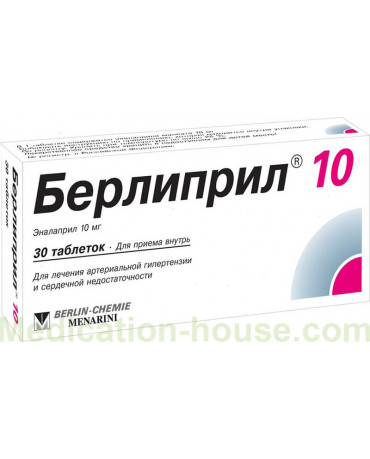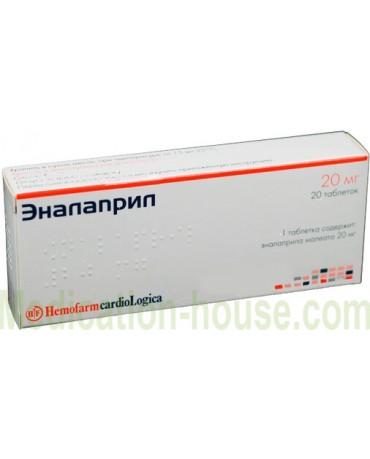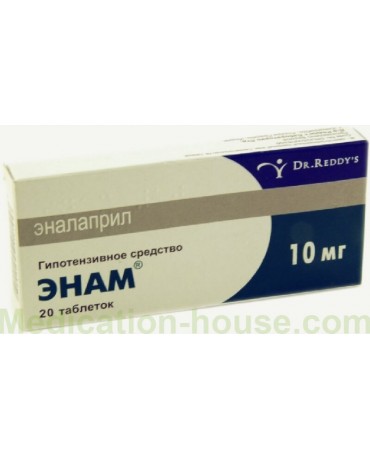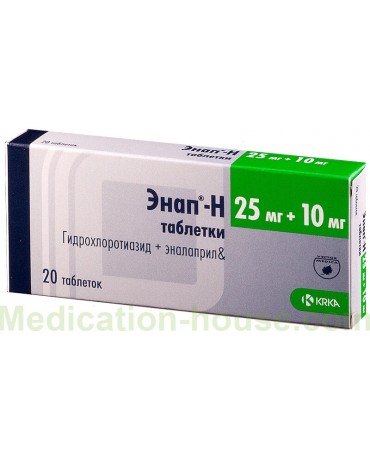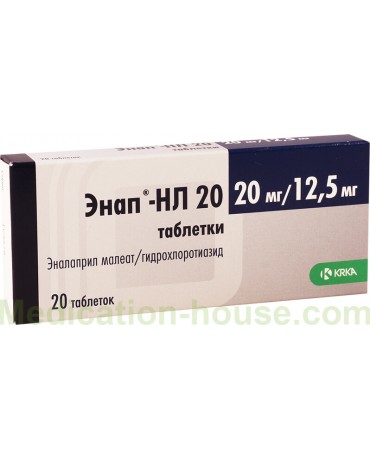User manual for Enap
To buy Enap just add it to your shopping cart
Enap is an ACE inhibitor.
Composition and release form
The drug is available in tablet form at a dosage of 2.5 mg, 5 mg, 10 mg and 20 mg. The active ingredient of the drug is enalapril maleate.
Additional components: lactose monohydrate, hyprolose, magnesium stearate, talc, sodium bicarbonate, corn starch.
In blisters of 10 tablets. 20 tablets in a carton box (two blisters).
Pharmachologic effect
According to the instructions Enap is an ACE inhibitor, an antihypertensive drug and a "prodrug" resulting in the formation of enalaprilat. The mechanism of action of Enap is caused by the inhibition of ACE activity, which occurs under the influence of enalaprilat. This leads to a decrease in systolic and diastolic blood pressure, as well as a decrease in the load on the myocardium.
According to reviews, Enap dilates the arteries to a greater extent, not the veins. A significant reflex increase in heart rate is not observed in this case.
Within therapeutic limits, a decrease in blood pressure does not affect cerebral circulation, and against a background of reduced pressure, blood flow in the vessels of the brain is maintained at a sufficient level. In addition, the use of Enap causes an increase in the blood supply to the renal and coronary blood flow.
Long-term use of Enap causes a decrease in myocytes in the walls of resistive arteries and a decrease in left ventricular hypertrophy of the myocardium, slows down the development of left ventricular dilatation and prevents the development of heart failure. The blood circulation of the ischemic myocardium improves.
Enalapril inhibits platelet aggregation and produces a mild diuretic effect.
The drug or an analogue of Enap begins to act about an hour after taking it, and after four hours it reaches a maximum. The drug works throughout the day.
Indications for use
According to the instructions, Enap is indicated for arterial hypertension.
Indications for Enap in combination with other drugs are:
chronic heart failure;
dysfunction of the left ventricle without severe symptoms.
Contraindications
The instructions for Enap contain the following contraindications:
porphyria;
hypersensitivity to enalapril and additional components of the drug;
a history of angioedema;
the period of pregnancy and breastfeeding;
children under six years of age.
According to reviews, Enap should be prescribed with caution when:
renal artery stenosis;
diabetes mellitus;
hyperkalemia;
idiopathic hypertrophic subaortic stenosis;
primary hyperaldosteronism;
aortic stenosis;
ischemic heart disease;
kidney failure;
systemic diseases of the connective tissues.
Method of application and dosage regimen
According to the instructions Enap is intended for oral administration. It is preferable to take the drug at the same time to achieve the greatest therapeutic effect.
In case of arterial hypertension, the recommended dosage of the drug or analogue of Enap is 5 mg once a day, with a gradual increase in dosage, but not more often than once every two weeks. As a rule, the maintenance dosage is 10-20 mg per day. The maximum dosage per day is 40 mg. It is advisable to divide too high a dosage into two doses.
For patients taking diuretics, the initial dosage of enalapril is 2.5 mg per day.
In case of hyponatremia or serum creatinine content of more than 140 μmol / l, the initial dosage of the drug should not exceed 2.5 mg per day.
In kidney disease, the dosage is determined depending on the indications for Enap and on the renal function. With QC more than 30 ml per minute, the initial dosage should not exceed 5 mg per day; with CC less than 30 ml per minute - no more than 2.5 mg per day, with a gradual increase in dosage to the optimal one.
In old age, taking the drug or an analogue of Enap can cause a lengthening of its action time and a more pronounced hypotensive effect, therefore the initial dosage should not exceed 1.25 mg, with a gradual increase to optimal.
In chronic heart failure, the initial dosage of Enap, according to the instructions, is 2.5 mg once a day, with a gradual increase to optimal, but not more often than once every two weeks. On average, the optimal dosage is 10-20 mg per day.
For the treatment of asymptomatic left ventricular dysfunction, the recommended dosage of Enap is 2.5 mg twice a day, with a gradual increase to 10 mg twice a day.
Most often, treatment with Enap is long-term, usually throughout life, if there are no unwanted side effects that require its cancellation.
Overdose
An overdose of Enap, according to reviews, causes a strong decrease in blood pressure, up to the development of myocardial infarction, collapse, thromboembolic disorders or acute cerebrovascular accident. Overdose is often accompanied by convulsions and stupor.
Treatment must be carried out as follows:
put the patient on a bed with a low headboard;
in case of mild overdose, it is recommended to perform gastric lavage and carry out symptomatic treatment;
in more severe cases, it is necessary to carry out a number of measures in order to stabilize the pressure (administration of intravenous saline and plasma substitutes, hemodialysis).
Side effects
According to reviews, the drug causes the following side effects, which, as a rule, are mild and do not require discontinuation of the drug:
Cardiovascular system: chest pain, orthostatic collapse, lowering blood pressure, arrhythmia, pain in the heart, palpitations, Raynaud's syndrome, thromboembolism of the branches of the pulmonary artery.
Sense organs: tinnitus, impaired vision and hearing, impaired vestibular apparatus.
Peripheral and central nervous systems: headache, confusion, dizziness, drowsiness or insomnia, increased fatigue and weakness, depression, paresthesia.
Respiratory system: bronchospasm, hoarseness and sore throat, cough, pharyngitis, rhinorrhea, shortness of breath.
Digestive system: vomiting, abdominal pain, constipation or diarrhea, nausea, pancreatitis, increased activity of liver enzymes, intestinal obstruction, liver dysfunction.
Metabolism: hyponatremia, hyperkalemia.
Urinary system: hypercreatininemia, proteinuria, impaired renal function.
Hematopoietic system: agranulocytosis, thrombocytopenia, eosinophilia, neutropenia.
Allergies: angioedema, photosensitivity, urticaria, skin rash and itching, exfoliative dermatitis.
Dermatological reactions: alopecia, pemphigus.
Other side effects: hot flashes, increased ESR, decreased libido and potency.
Storage conditions
The drug is stored at room temperature for no longer than 36 months.
Terms of sell
You can buy Enap without a prescription.

